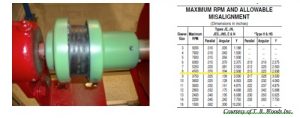Why do we need to align a coupling in the first place? If you ask the mechanic, maintenance manager, reliability technician, or plant engineer, you might get four different answers! But these are probably common:
- Increased reliability of the equipment being aligned.
- Decreased wear on bearings, seals, gears, couplings, shafts, and other components that make up the machines being aligned.
- Reduced vibration levels.
- Decreased energy consumption (typically a small amount, but sufficient misalignment can cause increased energy consumption).
- For warranty purposes, because OEM’s or owners specify it.
We can all agree on these. Now, let’s step it up a bit. How closely do we align? Ask the same group, and you will probably get differing answers again.
So, let’s take a common coupling – a T.B. Woods 8JE – and see what we find. This coupling is on a standard overhung water pump, axial suction, vertical discharge, operating at 1785 rpm.
Courtesy of T. B. Woods Inc.
-
- According to T. B. Woods, this coupling can tolerate a MAXIMUM misalignment of 0.020” offset (rim reading), and 0.094” of angularity (face reading). Woods is not being deceptive in their statement. It is a maximum value, not an alignment tolerance.
- According to the plant engineering department, the company alignment tolerance is 0.005” Rim and face (angularity and offset).
- According to VibrAlign, the recommended shaft alignment tolerance is 0.0007” per inch of angularity, and 0.004” offset. (The other laser alignment tool manufacturers are relatively close to the same tolerance.)
- Ask the millwright and they may say, “I get mine to +/- 0.002” (we are a proud bunch!).
| If I selected the tightestalignment tolerances from these different sources, and made it my alignment target, could I achieve it in a reasonable amount of time? |  |
- With laser alignment tools? Yes, and they do the math for you!
- With dial indicators? Probably so, if you’re good, and know how. But it will almost surely take longer.
- With a straight edge and feeler gauges or calipers? You might, but it’s going to take many hours, several repetitions, and a great deal of added effort.
If you can achieve a great alignment in a reasonable amount of time, why not do it? To my knowledge, you really can’t align shafts too closely. In our training classes and our service work, we routinely align shafts to within 1 mil offset, and .3 mils angularity per inch-usually within 30 minutes, and one spin of the shafts.
So, if you can achieve a really close tolerance in a minimal amount of time, why not do it right, do it once, and forget about it!
For more information, email Stan at stan.riddle@vibralign.com or visit www.vibralign.com





Comments